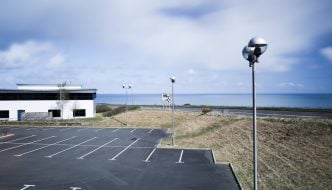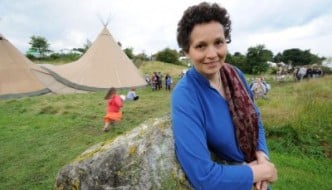An Interview With Spanish Illustrator And Graphic Designer Alba Ceide
April 1, 2015
Alba Ceide is a Spanish illustrator and graphic designer who lives and works in London. She studied Fine Arts at the Universities of Salamanca and Valencia and, after finishing her degree, she studied an MA in Madrid to become an art teacher. Alba has exhibited her art in different cities around Spain, and lately she has collaborated in an exhibition with several Spanish artists who live in London.
Two of Alba’s main preoccupations are women (Onírica Venus) and futuristic science fiction worlds (Xx Proyecto Valkiria). She mixes surrealistic images from her imagination and translates them into visual art. Onírica Venus is a collection of pictures of women from today’s world. Alba depicts them with wit and humor. I like three pictures of this collection where she presents three different types of women’s body and shows these women as superheroines. She started this project when she was at university and she presented some of these paintings to different exhibitions where she showed her art. (Her exhibitions where in A Coruña and Valencia.)
Some of Alba’s work makes us question and think about our society. For example, London is a picture that Alba presented with a collective of Spanish artists for an exhibition. In this piece, we see a woman facing the public with an arrogant pose as she’s standing on a pile of rubbish surrounded by CCTV cameras. This picture might appear a bit harsh, but the reality is it’s a perfect example of London: a city full of people far too concerned with buying their next Starbucks coffee than paying attention to the dirt that surrounds them.
Nowadays Alba is working on a series of portraits based on book characters whilst pursuing a career as an artist in London.

Superheroinas © Alba Ceide
TSOTA: What is your first artistic memory?
AC: I grew up in a stimulating artistic environment because of my family’s love for art, cinema and literature: the poetry and music of my brother Fernando, the passion for literature and fantastic worlds of my mum, and the extraordinary drawing skills of my dad. I was extremely impressed with his drawings and how he was able to sketch figures with such awesome abilities.
TSOTA: Which artists inspired you the most while you were studying art?
AC: For sure the first artists I took inspiration from were Jorge Carmona, Mariola Romero Gallardo and Pedro Bueno, from whom I learnt to draw since I was a child. Jorge and Mariola aroused my interest in anatomy with artists such as Michelangelo and Leonardo. The Renaissance classics became my first influence during my drawing studies in addition to the sensuality of Frank Frazetta’s artwork, the electricity of Derek Riggs, the surrealistic scenes of Dali and the darkness of Goya’s drawings. Later on at university the continuous exchange of knowledge with other students showed me many classic and contemporary artists such as Lucian Freud, Egon Schiele, Katsuhiro Ōtomo (Akira revolutionized my mind), HR Giger, Louise Bourgeois, Juan Muñoz, Daikichi Amano, Dave McKean, Dina Goldstein, Allan Moore, Marjane Satrapi and Tim Sale – also colleagues and friends I worked with together in projects and lessons gave me inspiration, such as Daniel de Rojas, Elena Bandos, Antonio Lorente, Rubén Galera and Livia Conuve.
TSOTA: In your work, you paint mainly female characters. Do you think we see enough art made by women?
AC: We don’t see very much. We are living, consuming and producing in the cultural heritage of a society that has been barred to women, therefore we have a masculine artistic heritage. And that’s what we see. Women have been deprived of being part of the art creation process and recognition, and they are still an exception in the artistic panorama. The presence of women in contemporary art is still a rarity and more effort is needed to change this. There are lots of women creating art, my art lessons at university were dominated by their presence, but they are still just a symbolic number in the professional art world. The semi-invisible presence of women as creatives will not change while male/female stereotypes are maintained in contemporary culture, so we should continue to claim for recognition in all aspects of life.
TSOTA: Futuristic figures are easily spotted in your artwork. What influenced these pictures?
AC: I love science fiction and the work of Philip K. Dick, Isaac Asimov and Aldous Huxley have inspired me a lot but Akira by Katsuhiro Otomo revealed to me graphic and narrative possibilities I had never considered before. Then I read Blame and NOiSE by Tsutomu Nihei, where the characters are involved in a dizzying wired landscape that I found graphically amazing and conceptually very expressive. Again I guess there are a lot of elements that inspired me in my futuristic figures, such as the film Brazil by Terry Gilliam, some album covers by Derek Rigg, and the film Metropolis by Fritz Lang.

Agora © Alba Ceide
TSOTA: What is your artistic routine like? Do you need a special environment to feel in the mood to start painting/drawing?
AC: I normally draw at home but working outside is also very stimulating and inspirational, so I always carry a notebook in the rucksack to note ideas, develop a project, or start some sketches, and I also move my laptop from home to draw/design in a different environment. I have a schedule to prioritize and organize projects and I have a habit of drawing at night. This happens mostly when I have to focus on a project that involves long work sessions, such as the drawings for Reverse Portraits, a project I’m working on now – plenty of coffee, hummus crackers, RockFM and Youtube jazz sessions.
TSOTA: On the subject of your new project, Reverse Portraits: what inspired this?
AC: The project started without being a project. Because of my graphic designs I spend many hours in front of the computer, and I was looking forward to doing a pencil self-portrait. So one night I photographed myself and I started drawing my head carefully. When you are very focused drawing it’s easy to loose the whole perspective, and you can do silly mistakes, so to avoid this I usually put the drawing in front of a mirror to refresh my mind with the inverted image, as my first drawing teachers taught me.
At a certain point, I saw the pencil portrait reflected in a mirror: it was practically done but it was floating in a white space. Nothing wrong with this, I like plain backgrounds, and the image itself was very strong and inspirational. The pencil-girl (at this point of the process still bald) was holding pencils and drawing herself, and I thought she could be doing so in the world she’d like to imagine; I immediately found parallels with this idea and Alice through the looking glass by Lewis Carroll.
I imagined the background I would draw around my Alice, and I drew it. I started to have ideas for the next drawings, and some posters, and… the ideas became a project. Now it’s one of the self-initiated projects I’m doing: a hybrid between drawing and design, integrating the identity of classic English literature characters with people I know in London. The core of the project is pencil portraits and graphic design material that I create on the computer with Illustrator and Photoshop.
TSOTA: We live in a time in which governments do not invest enough in arts. Do you think this should change?
AC: Of course. Art is a powerful resource that deserves much more consideration not only because images are all around us but also because people need serious visual education to understand the contemporary world. Images are making our world and we should understand what they are talking about.
Art is sadly used in many cases just as distraction and entertainment (cinemas and museums are still places for rainy days) and in the end, artistic language comprehension is relegated to small intellectual circles. I realized while studying for the MA how poor is the general art education given to children. They will be tomorrow’s viewers and most of them will still consider art filling chromatic circle templates with watercolor.

London © Alba Ceide
TSOTA: At the moment you are living in London. Which are the things you like the most and the least about the city?
AC: What do I like the most? I like its personality. London is a place of continuous events and soaks up everything that happens to it. It’s a city of pilgrim ideas. It’s like a huge port where people come, stay, live, leave, live again – they’re gone and they’re back again. This sort of dance creates knowledge, desires, fears, love and art. It’s a big city and I like the wholeness of it that includes cultures from all over the world, extravagant ideas and trends, the best designs, highly creative artists and the most tacky things ever seen. There are foxes in the street, squirrels, crows, little houses with funny chimneys, people playing frisbee in parks, perfume sellers in pub loos, amazing performers in the streets, incredible musician in the Tube, jacked potatoes and even the “World’s End Generator” modus of Tesco’s self-checkout when it detects an invisible item in its tray. London is an intense city to live in and I’m happy to live in it, especially in the summer: London’s summer is awesome. What I like the least? London doesn’t have a sea. It’s like a port with no sea.
Lucía Vázquez Bonome
You can see more of Alba’s work here: albaceide.com and follow her projects here: www.behance.net/albaceide
Filed under: Art & Photography
Tagged with: artist, design, illustration, interview, London, spanish



Comments